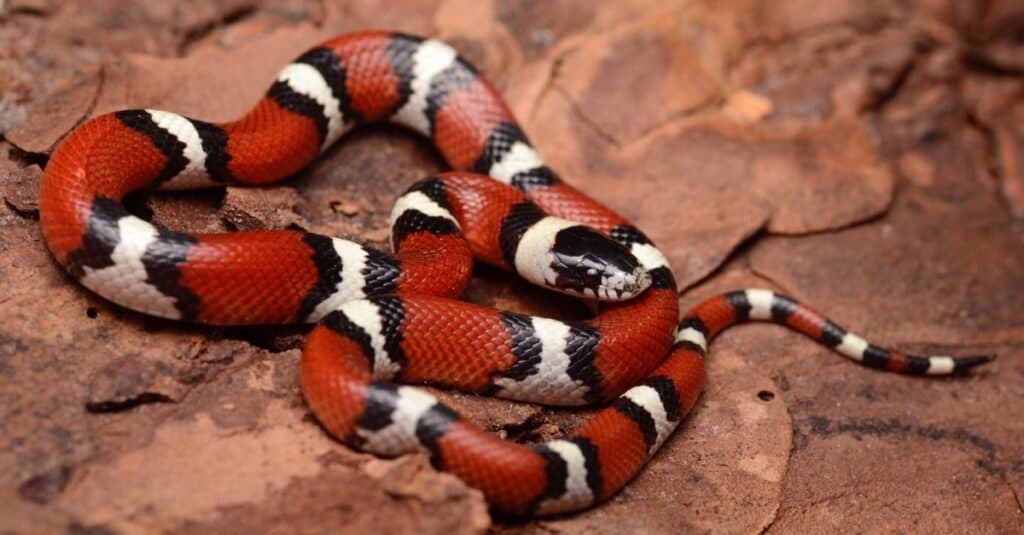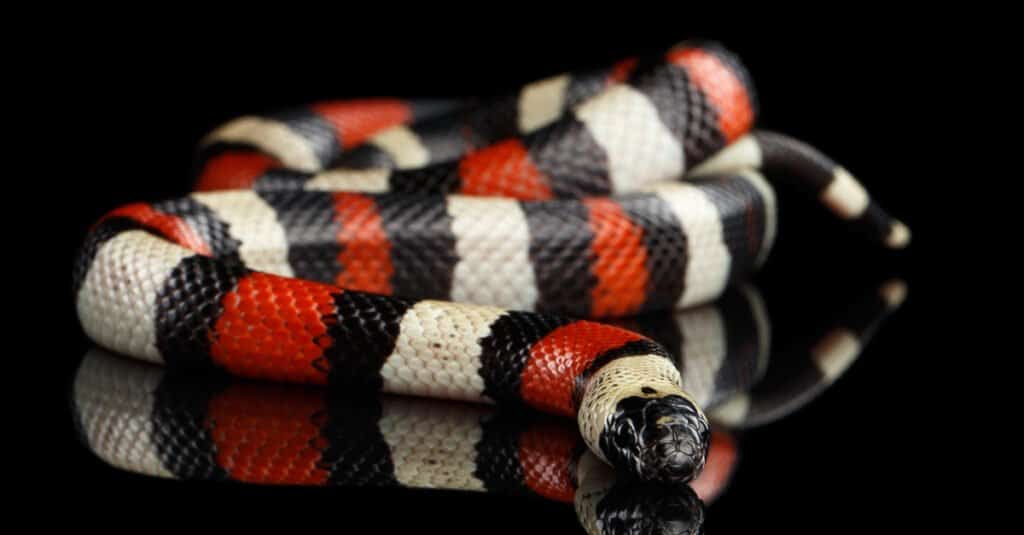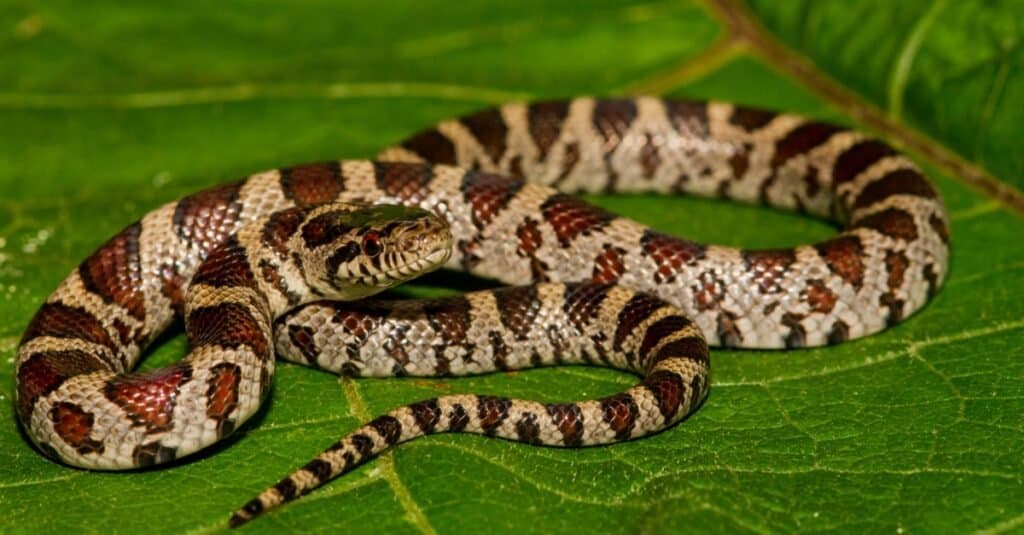Milk snakes are beautiful reptiles that fall under the umbrella of the kingsnake species. Native to the United States, Canada, and Central and South America, these common snakes often are mistaken for their more dangerous lookalike, coral snakes. Legend holds that milk snakes got their name after they would sneak into barns and milk cows. While that may not be true, milk snakes and their dietary preferences are special, albeit dairy-free. Let’s learn about these wonderful snakes and discover: what do milk snakes eat?
What do milk snakes eat?

Milk snakes eat
lizards
, rodents, birds, eggs, and other snakes.
©TheTexasNaturalist/Shutterstock.com
Milk snakes are carnivores that eat lizards, rodents, snakes, birds, and eggs.
As carnivores, milk snakes only eat other living things, particularly reptiles, insects, and rodents. When it comes to their diet, they aren’t too picky and will usually eat anything that they can easily kill. Their specific diet will vary depending on their exact geography, but wild milk snakes all eat similar things.
When they are young, milk snakes feed on small prey typically limited to insects and slow-moving worms. Their juvenile diet includes things like crickets, slugs, earthworms, and where available, small lizards and skinks.
Once they get older and larger, their diets generally broaden. Most of their dietary nutrition comes from small mammals. Rats, mice, voles, and other rodents are their most common food in the wild, although captive snakes may have a different diet.
Aside from rodents, milk snakes prey on reptiles. Lizards, skinks, and other snakes are common prey, especially in warmer climates. Milk snakes even have the ability to kill and eat venomous snakes, although they aren’t venomous themselves. Eating rodents and venomous snakes, milk snakes play a crucial role in any ecosystem they live.
Additionally, milk snakes eat birds and bird eggs. Although they are terrestrial, they have the ability to climb and swim. This gives them the ability to reach nesting birds and their nests.
A complete list of the foods milk snakes eat

Milk snakes often eat other snakes and are specially adapted to do so.,
©Seregraff/Shutterstock.com
Milk snakes eat about once every two weeks. Here is a complete list of foods that milk snakes eat:
- mice
- rats
- voles
- moles
- lizards
- skinks
- frogs
- snakes
- snake eggs
- birds
- bird eggs
- insects
Juvenile milk snakes eat mostly insects (and potentially small snakes), while adults primarily feed on rodents.
How do milk snakes hunt?
Milk snakes kill a variety of prey, but their hunting strategy remains similar for all of them. Let’s take a look at the methods a milk snake uses to hunt.
Nocturnal animals, milk snakes come out at dusk and stay out during the night. Occasionally, if it’s particularly wet or cool, they will come out during the day to hunt. Once they start hunting, they slowly move around, looking for their favorite foods (or anything they happen to come across).
After they have identified prey, they will strike with small teeth and grab a hold with their bodies. Wrapping and coiling around their future meal, they slowly squeeze with their strong muscles. Each time their prey exhales, they get a tiny bit tighter, making it harder to breathe and eventually suffocating the animal. When compared to pythons and boas, kingsnakes are stronger for their weight, providing higher constriction per pound. This is theorized to be an adaption for killing other snakes since they breathe less.
Where do milk snakes live?
Milk snakes are a widely distributed species of snake that can be found from southeastern Canada all the way through South America. Generally, they prefer woodland and can be seen among leaves and on the forest floor.
Additionally, they can be found in prairies and meadows, especially in certain climates. Prairies are often home to small rodents, making sense of their preference. In other climates, milk snakes are known to inhabit rocky cliffs and slopes. Essentially, anywhere there are rodents, you will find milk snakes.
Their name comes from a fable that milk snakes milk cows udders for food. This isn’t true but likely originated because of how often they are found inside barns. They often prefer to cool dark environment that barns provide, as well as the foods that usually live in those environments.
Are milk snakes venomous?

Eastern milk snakes are very beneficial animals, especially for farmers, as they hunt down small rodents often found on farm buildings and barns.
©Jay Ondreicka/Shutterstock.com
Milk snakes are not venomous and instead hunt using powerful construction. They do, however, imitate venomous snakes on purpose. This behavior is known as Batesian mimicry and is the evolutionary practice of a harmless species imitating a more dangerous one.
The eastern milk snake is one of the most commonly misidentified snakes as it comes in so many colors and variations. One of the common misidentifications is between the copperheads and milk snakes. Copperheads are venomous and milk snakes mimic this as a defense mechanism. Milk snakes are usually thinner, shinier, and will rattle their tails, pretending to be rattlesnakes. Either way, you shouldn’t kill them.
Another common misidentification is between coral snakes and red milk snakes. They both have striating bands of red, yellow, and black. While common sayings like “red touch yellow, kill a fellow” are popular, they aren’t often true and can result in injury. Coral snakes are some of the most venomous snakes in the world, however. Also, they are rarely found in one another’s habitat.
While milk snakes aren’t venomous, they are active predators of nearly all other snakes. As part of the kingsnake family, they are ophiophagous, meaning they eat other snakes. Some species of kingsnake are even immune to the venom of other snakes, making them excellent at hunting their dangerous cousins.
What do I feed a pet milk snake?
Generally, adult milk snakes are fed a small mouse or rat once a week. While live feeding may be entertaining, thawed or frozen food is safer and less likely to result in injury. When milk snakes are small, pinkie mice are usually given every 3-5 days. Additionally, it’s important to keep any food given to snakes small in width than the widest point of the snake. This allows them to safely eat and swallow the food without becoming impacted.
The photo featured at the top of this post is © Siarhei Kasilau/Shutterstock.com
Discover the "Monster" Snake 5X Bigger than an Anaconda
Every day A-Z Animals sends out some of the most incredible facts in the world from our free newsletter. Want to discover the 10 most beautiful snakes in the world, a "snake island" where you're never more than 3 feet from danger, or a "monster" snake 5X larger than an anaconda? Then sign up right now and you'll start receiving our daily newsletter absolutely free.
Thank you for reading! Have some feedback for us? Contact the AZ Animals editorial team.






